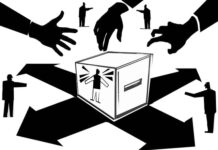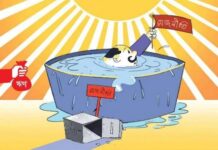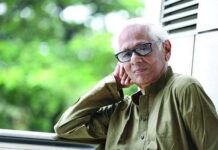
Here we are trying to tell the world, and justifiably so, that we are about to graduate into the outer periphery of the club of developed countries. For a country that was unfairly stigmatised as a “basket case” and thought of as a permanent drag by the international community—and one that has had humungous development challenges from its very inception—to come as far as we have is, by all standards, a remarkable achievement. The latest IMF’s World Economic Outlook puts us ahead of India in terms of per capita GDP by the end of the year. Obviously, this further strengthens our credentials as achievers.
But how is our coming of age to be measured? Is it just by per capita income or GDP figures or such indices? There are many other such numbers that show us in a favourable light. They are all very important and we are proud of those achievements. But what about some other signs of development—decent and safe roads, clean air, a dependable public transport system, safe water supply, reliable public healthcare, public education measured not by quantity but quality, and most importantly, safety for women? What about freedom of speech, right to dissent and right to assemble peacefully? What about the way we treat the individual human being who has been reduced to a mere statistic? For example, we lustily wait for money from our expatriate workers and yet unjustly, and some would say illegally, imprison them when they return having lost everything, not to mention the sufferings we put them through when things go wrong. Have we advanced in these areas as we have done in others?
Permit me to focus on something very specific. A sight that I find particularly offensive and demeaning as a citizen of a free and independent country is that of the police routinely attacking groups of demonstrators with batons as if they are nothing more than an aggregate of flesh and bones to be beaten, injured, maimed and brutalised in every possible way, without the slightest acknowledgement that they are citizens of an independent country with specific legal rights and entitled to minimum dignity and respect. The footage we see on television and photographs that we regularly publish of these incidents in this newspaper and others make me feel as if we are still in the colonial era when white Saheb-run police would swoop down on the brown natives, breaking their bones, because they had the temerity to “demand”. How dare they! Twice freed—once from the British and then from the Pakistanis—we still have not accepted the fact that every citizen has the right to inquire, question, demand and, when necessary, protest. We decry the colonial attitude in so many things but when it comes to treating a demonstration, the old colonial way of police brutality is still the norm—a police whose salary, uniform, every perk, and even the baton they beat us with are paid for by our tax money.
This is such an irony. The protest culture was almost a tradition for us, and it is rooted in our anti-colonial, anti-Pakistan and anti-military dictatorship struggles. Today’s democracy—whatever is left of it—is the direct result of the anti-autocracy movement against the Ershad regime. Yet this tradition now lies in tatters, partly due to misuse but more so because of the present anti-democratic attitude and the resultant suppressive measures adopted. I will be the first one to admit that on some occasions these civic movements turned violent and did result in destruction of properties and loss of lives. However, by and large, our tradition of mass demonstration has been peaceful, and on the occasions that it turned violent, it was more due to police action and the presence of police agents and saboteurs within.
The saddest aspect of our present protest culture is the near-destruction of our student politics, which is among our most glorious heritage. What happened to it, and why, is a subject for another day.
Recently, a group of left-leaning students and civil society members organised a “Long March” from Dhaka to Noakhali to protest against the growing incidents of violence against women. On their way, at Feni, they were attacked and the buses that were carrying them were vandalised by AL activists with the police either quickly following suit or watching the mayhem from a distance. The protesters were subsequently able to reach Noakhali and complete their programme without any further incident.
This attack on protesters was not an isolated event. The agitation for workers’ safety rights following the infamous Rana Plaza incident was attacked by the police in 2013. In the following year, a protest against the coal mine in Barapukuria ended in police violence. In 2015, a demonstration by private university students against VAT on their tuition fees was set upon by the police, and many homes were raided and a number of students arrested. Many are still entangled in court cases even after several years have passed. In the same year, a protest against the Rampal coal power plant titled “Road March to Save the Sundarbans” came under police attack. In 2018, a student’s demonstration against the quota system in government jobs faced police brutality, this time joined by the AL goons. Then school students, triggered into agitation by the sudden death of two fellow students under the wheels of a recklessly driven bus, spontaneously started the “Road Safety” movement. It was allowed for the first few days, and when the government saw it gathering momentum, it unleashed the police and party thugs against young students. Last year, a simple demonstration by jute workers demanding their arrears was attacked by the law enforcers. This year, state jute mill workers came under heavy police attack while they were demonstrating for their separation payments.
It is clear from the above instances—and there are numerous others that we did not cite due to space constraints—that the spontaneous agitations of general students later joined by the public at large all ended up under police baton, resulting in serious injuries, court cases, and arrests. Generally, the demonstrators are looked upon as enemies and, as such, have to be crushed and done so with brute force. Today, people are not only NOT allowed to protest but they are also treated with insult, humiliation and violence.
Intolerance of dissent is the primary cause of such brutal treatment of agitations. It could also come from fear… fear that if demonstrations are not nipped in the bud, they may grow into serious threats to the regime. The history of such fears is that they are often self-fulfilling.
Mahfuz Anam is Editor and Publisher, The Daily Star.









